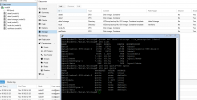You usually don't need to mount ZFS datasets with fstab.
Are you sure you used the correct mountpoint? In the screenshot you used "/data1/storage" as path for the directory storage but earlier you showed the output of
Or is "storage" just a folder inside your pools root and not a proper dataset? In that case you would need to use
Are you sure you used the correct mountpoint? In the screenshot you used "/data1/storage" as path for the directory storage but earlier you showed the output of
zfs get compression where no dataset "storage" on the pool "data1" existed.Or is "storage" just a folder inside your pools root and not a proper dataset? In that case you would need to use
pvesm set data1-storage --is_mountpoint /data1 as then "/data1" would be the mountpoint and "storage" would just be a subfolder of it.
Last edited:


